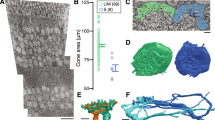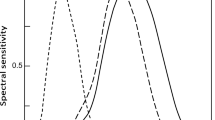Abstract
COLOUR vision in humans and Old World monkeys begins with the differential activation of three types of cone photoreceptor which are maximally sensitive to short (S), medium (M) and long (L) wavelengths. Signals from the three cone types are relayed to the retinal ganglion cells via cone-specific bipolar cell types1–4. Colour-coding ganglion cells fall into two major physiological classes: the red–green opponent cells, which receive antagonistic input from M- and L-sensitive cones, and the blue–yellow opponent cells, which receive input from S-sensitive cones, opposed by combined M- and L-cone input. The neural mechanisms producing colour opponency are not understood. It has been assumed that both kinds of opponent signals are transmitted to the lateral geniculate nucleus by one type of ganglion cell, the midget cell5,6. We now report that a distinct non-midget ganglion cell type, the small bistratified cell, corresponds to the physiological type that receivesexcitatory input from S cones, the 'blue-on' cell. Our results thus demonstrate an anatomically distinct pathway that conveys S-cone signals to the brain. The morphology of the blue-on cell also suggests a novel hypothesis for the retinal circuitry underlying the blue–yellow opponent response.
Similar content being viewed by others
References
Mariani, A. P. Nature 308, 184–186 (1984).
Kouyama, N. & Marshak, D. W. J. Neurosci. 3, 1233–1252 (1992).
Boycott, B. B. & Wässle, H. Eur. J. Neurosci. 3, 1069–1088 (1991).
Reid, R. C. & Shapley, R. M. Nature 356, 716–718 (1992).
Leventhal, A. G., Rodieck, R. W. & Dreher, B. Science 213, 1139–1142 (1981).
Perry, V. H., Oehler, R. & Cowey, A. Neuroscience 12, 1101–1123 (1984).
De Monasterio, F. M. Brain Res. 166, 39–48 (1979).
Zrenner, E., Nelson, R. & Mariani, A. Brain Res. 262, 181–185 (1983).
Dacheux, R. F. & Raviola, E. Proc. R. Soc. B239, 213–230 (1990).
Dacey, D. M. Science 240, 1196–1198 (1988).
Swanson, W. H., Ueno, T., Smith, V. C. & Pokorny, J. J. opt. Soc. Am. A4, 1992–2005 (1987).
Famiglietti, E. V. Jr & Kolb, H. Science 194, 193–195 (1976).
Lee, B. B., Martin, P. R. & Valberg, A. J. Physiol., Lond. 404, 323–347 (1988).
Dacey, D. M. J. Neurosci. 13, 5334–5355 (1993).
Rodieck, R. W. in From Pigments to Perception (eds Valberg, A. & Lee, B. B.) 83–94 (Plenum, New York, 1991).
Dacey, D. M. Vis. Neurosci. 10, 1081–1098 (1993).
Zrenner, E. & Gouras, P. Vision Res. 21, 1605–1609 (1981).
De Monasterio, F. M. & Gouras, P. J. Physiol., Lond. 251, 167–195 (1975).
Wiesel, T. N. & Hubel, D. H. J. Neurophysiol. 29, 1115–1156 (1966).
Valberg, A., Lee, B. B. & Tigwell, D. A. Vision Res. 26, 1061–1064 (1986).
Nathans, J., Thomas, D. & Hogness, D. S. Science 232, 193–202 (1986).
Mollon, J. D. J. exp. Biol. 146, 21–38 (1989).
Mollon, J. D., Estevez, O. & Cavonius, C. R. in Vision: Coding and Efficiency (ed. Blakemore, C.) 119–131 (Cambridge Univ. Press, UK, 1990).
Schiller, P. H. & Malpeli, J. G. J. Neurophysiol. 41, 788–797 (1978).
Ts'o, T. & Gilbert, C. J. Neurosci. 8, 1712–1727 (1988).
Wyszecki, G. & Stiles, W. S. Color Science: Concepts and Methods, Quantitative Data and Formulae (Wiley, New York, 1982).
Smith, V. C. & Pokorny, J. Vis. Res. 15, 161–171 (1975).
Dacey, D. M. & Brace, S. Vis. Neurosci. 9, 279–290 (1992).
Author information
Authors and Affiliations
Rights and permissions
About this article
Cite this article
Dacey, D., Lee, B. The 'blue-on' opponent pathway in primate retina originates from a distinct bistratified ganglion cell type. Nature 367, 731–735 (1994). https://doi.org/10.1038/367731a0
Received:
Accepted:
Issue Date:
DOI: https://doi.org/10.1038/367731a0
- Springer Nature Limited
This article is cited by
-
Neurophysiology of the Flickering Light Perception
Neuroscience and Behavioral Physiology (2023)
-
Origins of direction selectivity in the primate retina
Nature Communications (2022)
-
Synaptic inputs to displaced intrinsically-photosensitive ganglion cells in macaque retina
Scientific Reports (2022)
-
The primary visual cortex of Cetartiodactyls: organization, cytoarchitectonics and comparison with perissodactyls and primates
Brain Structure and Function (2022)
-
Conducting Channels in the Visual System. The Third Channel
Neuroscience and Behavioral Physiology (2022)





